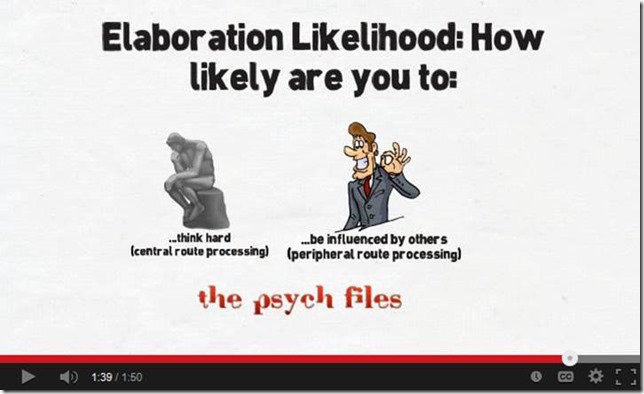In the last twelve months, conversion rate optimization has become an important part of our online marketing strategies. And more companies are now A/B testing and performing usability tests compared last year. The goal of conversion rate optimization is to get more people to complete a goal on your website - But what businesses really want is increased revenue.
You have read how culture impacts conversion rates and how the human brain can impact purchasing behavior. In the final part of this three part psychology of conversion series, we'll take a look at how you can use persuasive design to increase your revenue.
What Is Persuasive Design?
BJ Fogg, Stanford professor and one of the world's leading experts in digital persuasive design has described it as follows:
Persuasion is a form of social influence. In other words, you can use psychology in design to influence website behavior and encourage your web visitors to do what you want them to do!
What Does Persuasive Design Look Like?
Persuasive design happens all the time, both in the real world and online. In fact, it's probably happened to you two or three times today. Here are three examples of persuasive design in the real world:
Persuasive design #1: Speed bumps
You might see signs that say slow your speed leading up to a speed bump but when you see a speed bump, you will automatically change your driving behavior to anticipate stopping and starting while you drive over the bumps. You may go faster than the speed limit but speed bumps make it very uncomfortable.
Persuasive design #2: Public bathroom key
Have you ever wondered why public bathroom keys have large objects attached to them? Well, it's to keep you from accidently leaving the key in the bathroom or putting in your pocket and taking it with you. Having a large object makes it easy for you to give it back before you leave.
Persuasive design #3: Loyalty cards
Who doesn't love a free cupcake or cup of coffee? But does it really count as "free" when you have bought 11 or 12 previously? Punch cards are designed to persuade you to buy more in order to get one more for free.
How Effective Is Persuasive Design?
The average conversion rate for an ecommerce store is approx. 2-3%
 . Compare this to the average conversion rate in an offline store, which is approx. 20-40%, and we have to ask ourselves, why are conversion rates so low online?
. Compare this to the average conversion rate in an offline store, which is approx. 20-40%, and we have to ask ourselves, why are conversion rates so low online?
When shopping in a physical store, you are open to things that are not possible online. For example, in a physical store you can:
- Smell different perfumes before you decide to buy one
- Be greeted by name from the owner if you are a regular
- Ask a sales clerk how an item looks on you
Although conversion rates online are lower than offline, online has one distinctive advantage... We can measure everything!
Some of the best converting websites online have conversion rates between 15%-20%
 . It's no coincidence then that these sites use persuasive design to increase conversion rates.
. It's no coincidence then that these sites use persuasive design to increase conversion rates.
You can use the table below to see how you compare:
How Do We Make Decisions?
Research shows that more than 90% of our decisions are unconscious
 .
.
And we make decisions using the elaboration likelihood model. The model is comprised of two areas, high elaboration and low elaboration:
- High elaboration (central route): Requires a great deal of thought to make a decision
- Low elaboration (peripheral route): Requires little thought, reliant on decisional heuristics
And we have many biases that we're not even aware of. If we see that something is expensive, we immediately thing it is good quality (luxury fashion). Or if we see someone wearing a white coat, we instantly believe what they say is the truth (doctors).
But if I was to ask you what are you more terrified of, a shark or a dear, what would your answer be?
Most likely, you said shark, right?
But research shows that deer kill more people in the US per year than sharks do
 . So now which animal are you more afraid of?
. So now which animal are you more afraid of?
It's these kinds of biases that can be used on your website to help persuade visitors to spend more with you.
Six Principles Of Persuasion Design
Dr. Robert Cialdini, Professor of Psychology at Arizona State University is renowned for his principles of influence. And as one of the leading experts in the field of persuasion, he is best known for his 1984 book "Influence: The Psychology of Persuasion" .
In Influence: The Psychology of Persuasion, Cialdini cites six principles of persuasion. The six principles of persuasion are:
1. Reciprocation
2. Commitment & Consistency
3. Social proofing
4. Authority
5. Liking
6. Scarcity
Here's how the six principles are used on the web, with real examples.
1. Reciprocation
People are often inclined to return a favor. If you give away something of value for free, then they are more likely to reciprocate (give back). This is why businesses are willing to offer free samples or trials of their product or service, in hope of attracting new customers.
A great example of reciprocation is Dropbox. When you sign up to Dropbox, they will give you 500mb of space for every friend who joins. They persuade you to share their product and promote their brand and reciprocate the favor by giving you more free space.
2. Commitment & Consistency
People strive for consistency in our commitments, and we tend to follow pre-existing beliefs and behavior when making decisions. And people generally also value consistency in others. If someone makes a commitment in front of an audience, whether written or oral, they are more likely to uphold it and honor the commitment.
Not only do Toms sell great shoes, but they also donate a pair of shoes for every pair purchased with their One for One program. They are clearly committing to a great cause, which in turn persuades you to buy more as you are doing something good.
3. Social proofing
Humans are followers. Our very nature is to look at what others do and then do the same, especially if it's something new. We like familiar things, as familiar things appear safe.
Booking.com is great at using social proof to recommend hotels. They include star ratings, user reviews and show the number of people currently looking at the hotel information page. Booking.com persuades you to book with the top hotels that have excellent reviews.
4. Authority
People look to authoritative figure for advice and websites that show authority are trusted more than those that don't. If you have been verified by a third party, you will earn the trust of your web visitor. And B2B sites that show that their product/ software have been endorsed by an authoritative figure will be better received.
Neil Patel does a great job of persuading you to contact him on his website by using testimonials from experts at well-known brands such as Michael Arrington (TechCrunch), Tessa Burg (GM) and Ben Huh (I can Haz a Cheeseburger).
5. Liking
People buy from people they like. This applies to attractive people and people who look friendly and nice, or even you happen to share the same name with someone. Other examples of liking include:
- People like people who are like themselves
- People like those who pay them with compliments
- People like people that make them laugh
Jennifer Aniston is one of the most likable people on television and Aveeno were happy to spend millions of dollars on a campaign featuring her in hope to reach a wider audience and sell more products.
6. Scarcity
People want what they cannot have. Remember that T-shirt you almost bought but didn't, and you haven't seen it since? It will haunt you. Social psychology indicates that a loss is a more powerful emotion than a gain.
Amazon are masters of ecommerce and persuasion, and by using scarcity (only 3 left in stock!) they will increase the demand for the product and thus, sell more. Scarcity can be in the sense of product stock (only 20 left) or time limited (deal ends in 12 hours).
Conclusion
Marketing departments across the world are wasting their budgets in order to increase traffic and sales. But conversion rates are decreasing. And you now need to send more traffic to convert fewer visitors.
If you want to focus on a long-term strategy, use persuasive design throughout your marketing communication channels. Try to focus on understanding the psychology of your web visitor and don't just look for quick/ short-term wins.
Follow the six principles of persuasion and use persuasive to increase conversion sites for your business.
Have you used persuasion design on your website? Which principle works best for you? I'm looking forward to your comments below.
The 'Psychology of Conversion Optimization' Series
The Psychology of Conversion Optimization three part series includes:
1. Psychology of Conversion Optimization - Culture
2. Psychology of Conversion Optimization - The human brain
3. Psychology of Conversion Optimization - Persuasive design
This three part series details how you can use psychology to impact your marketing efforts. A lot of time and effort has been made in order to present research and actionable tips you can use to increase conversion rates. Please share this research on Twitter, LinkedIn and Google+.














